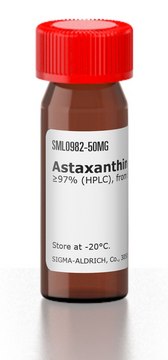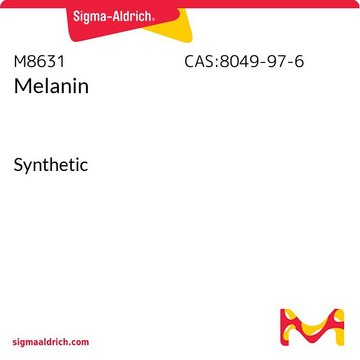L9879
Lycopene
≥90%, from tomato
Synonym(s):
ψ,ψ-Carotene, 2,6,10,14,19,23,27,31-Octamethyl-dotriaconta-2,6,8,10,12,14,16,18,20,22,24,26,30-tridecaene
About This Item
Recommended Products
biological source
tomato
Assay
≥90%
form
powder
shipped in
dry ice
storage temp.
−70°C
SMILES string
C\C(C)=C\CC\C(C)=C\C=C\C(C)=C\C=C\C(C)=C\C=C\C=C(C)\C=C\C=C(C)\C=C\C=C(/C)CC\C=C(\C)C
InChI
1S/C40H56/c1-33(2)19-13-23-37(7)27-17-31-39(9)29-15-25-35(5)21-11-12-22-36(6)26-16-30-40(10)32-18-28-38(8)24-14-20-34(3)4/h11-12,15-22,25-32H,13-14,23-24H2,1-10H3/b12-11+,25-15+,26-16+,31-17+,32-18+,35-21+,36-22+,37-27+,38-28+,39-29+,40-30+
InChI key
OAIJSZIZWZSQBC-GYZMGTAESA-N
Looking for similar products? Visit Product Comparison Guide
General description
Application
- in high performance liquid chromatography (HPLC) to determine its concentration in liver, kidney and lung tissue
- to induce urokinase plasminogen activator receptor (uPAR) IN prostate cancer cell line
- in Raman chemical imaging system to detect and visualize its internal distribution
Biochem/physiol Actions
Packaging
related product
Storage Class Code
11 - Combustible Solids
WGK
WGK 3
Flash Point(F)
Not applicable
Flash Point(C)
Not applicable
Personal Protective Equipment
Choose from one of the most recent versions:
Already Own This Product?
Find documentation for the products that you have recently purchased in the Document Library.
Which document(s) contains shelf-life or expiration date information for a given product?
If available for a given product, the recommended re-test date or the expiration date can be found on the Certificate of Analysis.
How do I get lot-specific information or a Certificate of Analysis?
The lot specific COA document can be found by entering the lot number above under the "Documents" section.
Is Product L9879, Lycopene, of the Trans or Cis stereoforms?
Based on the CAS number search in ACS database and the chemicals encyclopedia published by the Royal Society of Chemistry, this lycopene is an all-trans compound. The chemicals encyclopedia published by the Royal Society of Chemistry, 12th ed., Entry# 5650.
What is the method of preparation of Product L9879, Lycopene?
Details of the method of preparation are considered proprietary information. The last solvent that the lycopene comes into contact with is methanol. However, the material is dried extensively, so little, if any, methanol should be present.
How can Product L9879, Lycopene, be dissolved?
Lycopene dissolves in carbon disulfide (1 g/50 mL), boiling ether (1 g/3 L), boiling petroleum ether (1 g/12 L) or hexane at 0 °C (1 g/14 L). Lycopene is almost insoluble in methanol or ethanol, but is soluble in chloroform or benzene.
What is the solution stability of Product L9879, Lycopene?
A solution prepared under argon, protected from light and stored at -20 °C is stable for up to 48 hours. It is recommended to prepare solutions fresh each time and to prepare immediately before use.
How can I assess the condition of Product L9879, Lycopene, from its appearance?
We advise against using the product if it becomes speckled or has a "salt and pepper" appearance. An acceptable range of colors is from dark purple to reddish brown to brown.
What is the extinction coefficient of Lycopene, Product L9879?
Extinction Coefficients: For samples dissolved in petroleum ether, E1% = 3450 (at 472 nm), 2250 (at 446 nm) and 3150 (at 505 nm).
How do I find price and availability?
There are several ways to find pricing and availability for our products. Once you log onto our website, you will find the price and availability displayed on the product detail page. You can contact any of our Customer Sales and Service offices to receive a quote. USA customers: 1-800-325-3010 or view local office numbers.
What is the Department of Transportation shipping information for this product?
Transportation information can be found in Section 14 of the product's (M)SDS.To access the shipping information for this material, use the link on the product detail page for the product.
My question is not addressed here, how can I contact Technical Service for assistance?
Ask a Scientist here.
Articles
Cholesterol synthesis regulation by dietary levels, LDL receptors control lipid-rich LDL particle transport in cells.
Antioxidants protect biological systems from oxidative damage produced by oxygen-containing free radicals and from redoxactive transition metal ions such as iron, copper, and cadmium.
Our team of scientists has experience in all areas of research including Life Science, Material Science, Chemical Synthesis, Chromatography, Analytical and many others.
Contact Technical Service




